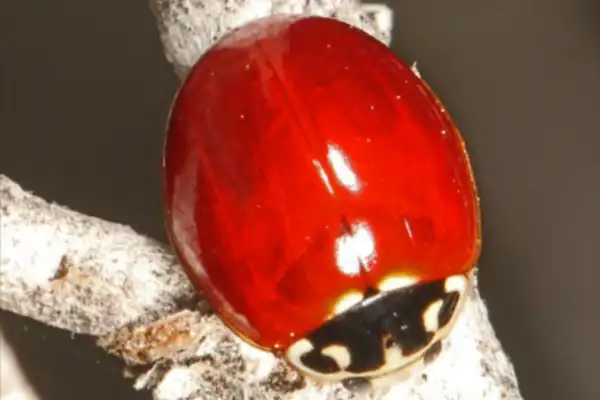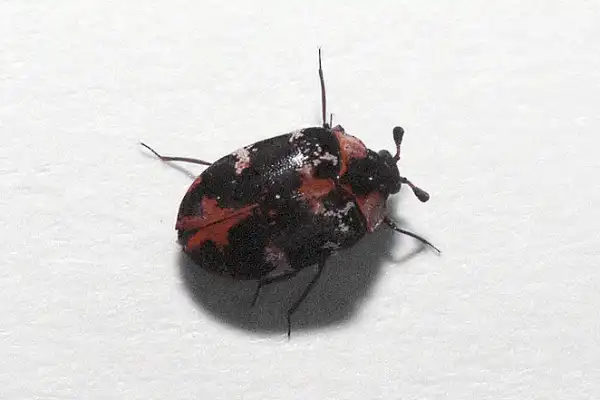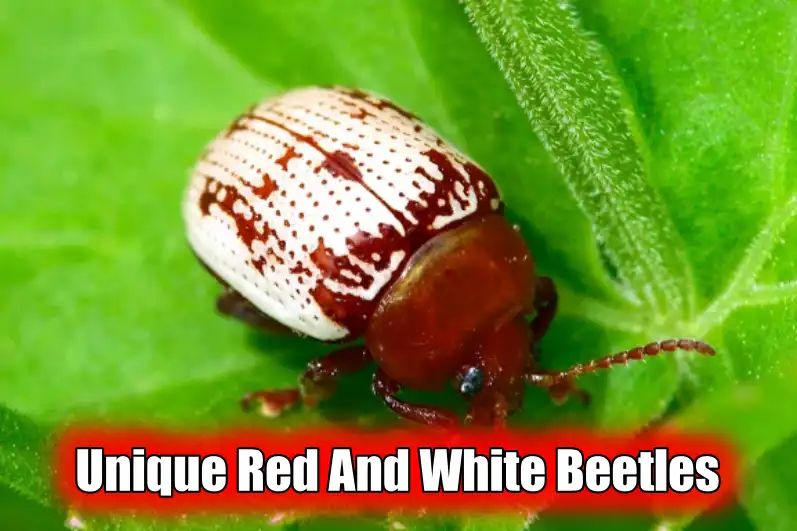There is a saying that anything goes well with white. But somehow red and white make a combination of colors that is outstanding from the rest of the color combinations. The red and white combination of colors represents innocence, peace, and cleanliness, according to color symbolism.
Ever heard of Sevenraj from Bangalore? This man is a celebrity known for his obsession with the red and white combination. Similar to that, these beetles here have patterns of red and white on their elytra.
20 Unique Red And White Beetles
1. Western Blood Red Lady Beetle

| Scientific Name | Cycloneda polita |
| Size | length of 4.25mm and width of 3.4mm |
| Identification | Red elytra with white rim and crescents |
| Geographical Location | North America |
If one is hyperopic, one can easily be fooled into thinking that this red and white beetle is a red blood drop. Assuming its size, it makes sense that we can fall into the illusion of thinking of it as a drop of red blood.
The sex of these red and white beetles can be identified by different facial marks on the beetle. These red and white beetles are also known as Polish lady beetles.
2. Tall Flea Beetle
| Scientific Name | Kuschelina floridana |
| Size | 5 to 6.5mm |
| Identification | black, yellow, and white stripes on the elytra and red rim |
| Geographical Location | Florida, USA |
This red and white beetle is a type of flea beetle that is small and jumps. The elytral puncturation seems very strong for these red and white beetles.
These beetles feed on blue hearts, which are a type of flowering plant. Though these flowering plants are endangered species. This beetle is also a type of leaf beetle.
3. Omophoita magniguttis
https://in.pinterest.com/pin/765823111662392768/
| Scientific name | Omophoita magniguttis |
| Size | 5mm |
| Identification | red elytra with white spots |
| Geographical Location | Central and South America |
These red and white beetles belong to the Oedionychin tribe and are widely distributed in the Neotropical regions.
These red and white beetles are known for having singular chromosomal features. Research is going on for these features of this red and white beetle. These beetles are also present in the central plateau of Mexico.
4. Common Carpet Beetle

| Scientific Name | Anthrenus scrophulariae |
| Size | 2.5 to 3.8mm |
| Identification | white and reddish scales on elytra |
| Geographical Identification | present all over the world |
Originally, this red-and-white beetle was found in Europe and the Middle East, but now it has spread worldwide. These beetles feed on the nectar and pollen of plants.
The larval stage of these red and white beetles causes huge economic damage. Textiles and carpets will be peppered, leaving a hole. The shed larval skin of this common carpet beetle causes dermatitis when it comes into contact with human skin.
5. Eucalyptus leaf beetle
https://in.pinterest.com/pin/765823111662392970/
| Scientific Name | Paropsisterna decolorata |
| Size | 3-17mm |
| Identification | red elytra with white spots completely spread |
| Geographical Location | Papa New Guinea and Australia |
One interesting fact about this red-and-white beetle is that its color fades away after death. These leaf beetles feed on the leaves of dicotyledon plants of the myrtle family.
Also, these red and white beetles feed on eucalyptus tree leaves, hence the name.
6. Blister Beetle of Texas
https://in.pinterest.com/pin/765823111662393047/
| Scientific Name | Pleuropasta reticulata |
| Size | 17mm |
| Identification | patterned reddish brown and white elytra |
| Geographical Location | Central America and North America |
The habitat of these red and white beetles is the Chihuahuan desert, and they mainly feed on the flowers of the woody crinkle mat.
Blister beetles secrete a defensive agent called cantharidin. This chemical causes blisters on contact with human skin, hence the name given to this red and white beetle that secretes this defensive blistering agent.
7. Cottonwood leaf beetle
https://in.pinterest.com/pin/765823111662393187/
| Scientific Name | Chrysomela scripta |
| Size | 17mm |
| Identification | white elytra with black spots and red rim or prothorax |
| Geographical Location | Central and South America |
This red and white beetle causes huge economic damage to the Populus species, which is cottonwood, and also feeds on the leaves of the basket willow. Hence, it is a severe pest to urban ornamental trees.
This red-and-white beetle can spend its entire lifespan on a single tree if food is available.
8. Common Asparagus Beetle
| Scientific Name | Crioceris asparagus |
| Size | 6 to 9.5mm |
| Identification | red-bordered elytra and cream or yellow spots on elytra |
| Geographical Location | Europe and North America |
These red and white beetles feed on the asparagus plant, which is also called sparrow grass. These beetles strip the leaves of asparagus, depriving the plant of the process of photosynthesis and also the storage of energy for future purposes.
In one year, these beetles will have two to three generations completed.
9. Sumac Flea Beetle
| Scientific Name | Blepharida rhois |
| Size | 6mm |
| Identification | red and white dots with yellow head |
| Geographical Location | North America |
These red and white beetles feed on sumac or cashew plants, also known as Anacardiceae. These beetles are leaf beetles that feed on only plant materials like leaves, pollen, and nectar.
Also, there is much research going on the shields of these beetles’ larvae stage. The shields of these larvae are known to have a protective barrier against predators.
10. Calligrapha leaf beetle
https://in.pinterest.com/pin/765823111662393643/
| Scientific Name | Calligrapha spiraeae |
| Size | 8mm |
| Identification | Red elytra with black and white spots |
| Geographical Location | Central And South America |
These red and white beetles mainly feed on ninebark plants, which are flowering plants widely distributed in North America. The bodies of these beetles are usually convex, with red elytra and black and white spots.
These beetles are leaf beetles that feed on plant material, and an advantage of this beetle is that it feeds on plants of less economic importance.
11. Passionflower Flea Beetle
| Scientific name | Disonycha discoidea |
| Size | 7-9mm |
| Identification | Large red elytra with black and white stripes |
| Geographical location | North America |
This beetle has a passion for passionflower; both larvae and adults are often found on passionflower.
The color of the beetle indicates a warning sign or danger for its predators. These beetles are usually found on poisonous plants. They collect cyanogenic glycosides from the passionflower plant, making it distasteful or toxic for its predators.
12. Asian Lady Beetle
| Scientific name | Harmonia axyridis |
| Size | 5-8mm |
| Identification | Red with 0-22 black spots and white pronotum |
| Geographical location | Eastern Asia |
The red-white beetle is commonly known as the Halloween beetle in North America as it invades homes during the winter and overwinters. The beetle is known for having many names, and when it first appeared in the UK, it was named ‘many-named ladybird‘ in jest. Its other names are multivariate, southern, Japanese, and pumpkin ladybird.
The red-white beetle does not appear in a single pattern; it may have a whole black body with red spots or no spots, but with all these, they are beautiful in every single type.
This beetle can be confused with other species, but its large size is the key to identification. Though their origins are in Asia, these beetles are seen worldwide. The red-white beetle is seen as a threat to some grape industries.
13. Convergent Lady Beetle
| Scientific name | Hippodamia convergens |
| Size | 5-7mm |
| Identification | Red elytra with 12 black spots |
| Geographical location | North America |
This is a rare case, but some of the unhatched eggs are eaten by the larvae to emerge first. The red-white beetles are natural pest control as they feed on small aphids. They detect their prey with the pheromones of the aphids. The beetles also feed on pollen and nectar from flowers.
The black spots on the elytra act as a warning sign to predators. Beetles with spots tend to be eaten less frequently than unspotted ones.
14. Seven-spotted Lady Beetle
| Scientific name | Coccinella septempunctata |
| Size | 7-12mm |
| Identification | red elytra, three black spots on each wing, and one on the junction |
| Geographical location | Europe |
The carnivorous red-white beetle is easily identifiable by its exact seven black spots on its body. Again, the color gives a warning sign, making them aware of their predators. The red-white beetles secrete fluid from the joints of their legs, which gives them a foul taste. These beetles are so clever that they play dead when threatened.
The red-white beetle is culturally important as it is the national insect of Finland and the state insect of many states. The beetle is a natural pest control tool and has been repeatedly introduced in North America to reduce aphid numbers.
15. Two Spotted Lady Beetle
| Scientific name | Adalia bipunctata |
| Size | 4-5mm |
| Identification | red elytra with two black spots on their wings |
| Geographical location | Western and Central Europe |
The female-dominated beetle has 80–90% female offspring. This is due to symbiosis with a symbiotic bacteria that is too big to live in male gametes. When the bacteria ends up in the male, the gamete dies, and hence the bacteria dies.
The dead gametes serve as food for their sisters when they hatch. The eggs are football-shaped and orange to pale yellow in color. The larvae, unlike the adults, are black in color.
You need to be careful of these beetles, as they carry sexually transmitted diseases.
This beetle, similar to other red-white lady beetles, feeds on aphids and is a natural pest control. The beetles are easily identified by their two spots, and that’s why their name. The truly melanistic type is really rare.
16. Three Banded Lady Beetle
| Scientific name | Coccinella trifasciata |
| Size | 4-5mm |
| Identification | Red in color with black bands |
| Geographical location | North America, Europe, and Northern Asia |
Have you ever wandered around in the garden and noticed this beetle, which has rather unique patterns on its body than other lady beetles? Well, you wouldn’t have.
Because if they were, their attractive bands surely would have caught your eye. But uniqueness is always rare, and this is too. The red beetle with white spots on its head is considered a species of greatest conservation need.
Anyone can differentiate the male from the female, as the male has a pale head and a black band across the base, while the female has a black head and two pale spots.
The beetle, like all other lady beetles, feeds on aphids.
17. Flea Beetle
| Scientific name | Disonycha tenuicornis |
| Size | Red elytra with thin black and white stripes |
| Identification | 8mm |
| Geographical location | Central and North America |
The red-white beetle looks similar to the passionflower beetle, but this one has thinner stripes than the other, and this beetle is rarer. The beetle does not look that bloody red when alive but is a little yellowish. The photograph of a spotted flea beetle is always in doubt, as they are very rare and only found in Arizona.
The antennae of the male are sometimes long and reach the middle of the elytra. The head of the red-white beetle is pale, and the pronotum has two black spots, making it look more intimidating.
18. Omophoita personata
| Scientific name | Omophoita personata |
| Size | 5mm |
| Identification | Red elytra with white patches like spots |
| Geographical location | Central America |
If you find these beetles anywhere, then you are really lucky. Because these beetles are rare. They are known for the many research studies going on about them. The red-white beetle has incomplete development or is immature.
It is believed that the beetle might be uncommon due to this reason. They have a larger chromosome, which is large enough to not come under autosomes. This is another hot topic of research on this beetle.
This beetle may be confused with its other, same-family species, but when seen closely, their patterns of white spots differ.
19. Splendid Tiger Beetle
| Scientific name | Cicindela splendida |
| Size | 11-15mm |
| Identification | Reddish with blue head and white markings |
| Geographical location | North America |
The beetle is identified by its shiny, bluish-green head. They are commonly found during the spring near clay banks and road cuts.
They usually occur in the same color as the soil they burrow under. They are camouflaged well in their environment. The beetle is quick in its escape flight and running, which is their defense mechanism against predators.
20. Zygogramma heterothecae
| Scientific name | Zygogramma heterothecae |
| Size | 5mm |
| Identification | Red elytra with black markings |
| Geographical location | North America |
The beetle is really beautiful. It seems as if someone is painted white on the red beetle. The beetle feeds on certain types of plants to impart a foul taste to predators who feed on them. This prevents their predators from feeding on other beetles. This mechanism is seen in many insects, like butterflies.
Conclusion
This was all about some of the red-white beetles. Though many of them seem the same, they are different, and some need proper identification to know what they are. I hope this helped you learn about some red-white species.
Also Read:

